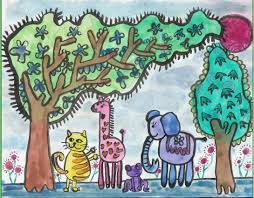When I was in college, I taught art classes to young adults with developmental disabilities. As a young person I had zero artistic skill, no teaching experience, and very little common sense. Oh, the mistakes I made! I nearly burnt down the parks and recreation building by baking Fimo, a plastic modeling clay at 500 degrees instead of 250 degrees, for one. What I had though, was an incredible enthusiasm and class enrollment quickly climbed from two participants to twenty four. I am proud to say art class was the most popular special education course offered by the parks and recreation department.
The problem became threefold: how to teach art with no artistic skill or training on a very slim supplies budget, and managing the many different personalities and quirks in the classroom. For example, there was a man I’ll call Ted who had prader willi syndrome, a chromosomal abnormality manifesting in high relative IQ but extremely disordered behavior. Ted would use his finger nails to pick into his leg and eat the flesh. I instituted the rule “No eating skin in class” as a result. There was a young woman with Downs Syndrome who would weep if her art was touched by another participant. “No touching Clara’s art” become another rule. There were a set of middle aged African American twins who sent their social security dollars crumpled up in the mail to country music stars in exchange for signed photographs. I was unable to convince them “no sending money to millionaire strangers” was another art class rule.
But my greatest challenge was a boy I’ll call Mark. Just like there are a variety of personalities in the general population, there are a variety of personalities among people with mental retardation, and Mark was just plain mean. He would sneak up behind the females and pinch their breasts when I wasn’t looking. He slouched in his chair and stuck his legs out to trip people and complained about every single project we did. “That’s dumb,” and “I don’t want to,” were his standard reactions to each week’s offering.
I begged my supervisor to let me kick him out of class but she refused, pointing out that I was there to serve people who did not have access to other activities. I would see Mark and swallow a great big sigh of annoyance, forcing myself to greet him with the same cheery “Hello” that I gave all the other, nicer students.
Then came the day that Mark died suddenly during a seizure in his home. My supervisor called to tell me. I was in the midst of finals and did not re-arrange them to attend his funeral.
With surprise and horror I learned that the eulogy delivered by his parents focused on how much art class had meant to him, how it was a source of light and joy at the end of his short life, how much he looked forward to coming each week, how much he talked about it at home.
If Mark was ill-behaved in art class, I was something much worse: I was unforgiving and blind to the significance of his return, week after week and month after month, to an activity that he had choice over, unlike the brain damage which limited his life in every way and killed him at the age of seventeen. I took personally behavior that had nothing to do with me.
Mark has been one of my greatest teachers in my work as a therapist, as a mother, as a friend and as a wife. My experience with him reminds me to look below the surface of things and to remember: Pay close attention. Don’t take it personally. I don’t know the whole story. More will be revealed.
